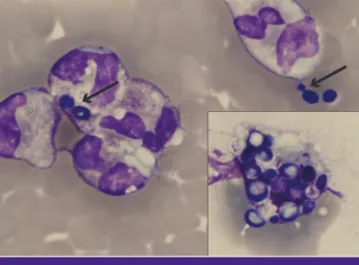Infection &
Chemotherapy
Received: August 22, 2016 Published online: December 12, 2016 Corresponding Author : Myungshin Kim, MD, PhD
Department of Laboratory Medicine, Seoul St. Mary’s Hospital, College of Medicine, The Catholic University of Korea, 222 Banpo-daero, Seocho-gu, Seoul 06591, Korea Tel: +82-2-2258-1645, Fax: +82-2-2258-1719
E-mail: microkim@catholic.ac.kr
This is an Open Access article distributed under the terms of the Creative Commons Attribution Non-Commercial License (http://creativecommons.org/licenses/by-nc/3.0) which permits unrestricted non-commercial use, distribution, and repro- duction in any medium, provided the original work is properly cited.
Copyrights © 2016 by The Korean Society of Infectious Diseases | Korean Society for Chemotherapy
www.icjournal.org
Budding Yeast Cells in Peripheral Blood Smear:
Clue to Candidemia
Sung-Yeon Cho
1,2, Hyojin Chae
3, Myungshin Kim
3, Dong-Gun Lee
1,2, and Hee-Je Kim
2,4,51Division of Infectious Diseases, Department of Internal Medicine, 2The Catholic Blood and Marrow Transplantation Center, 3Department of Laboratory Medicine, 4Division of Hematology, Department of Internal Medicine, Seoul St. Mary’s Hospital, College of Medicine, Cath- olic University of Korea, 5Leukemia Research Institute, College of Medicine, Catholic University of Korea, Seoul, Korea
Dear Editor,
A 46-year-old female patient with acute myeloid leukemia was admitted for the management of grade III acute graft-ver- sus-host disease (GVHD) of gut, liver, and skin, 74 days after successful haploidentical hematopoietic stem cell transplanta- tion. Methylprednisolone (250 mg/day) was started with tacro- limus intravenously (starting dose of 0.5 mg/day, modified ac- cording to the serum trough level of 5-15 ng/mL) for the management of GVHD. Despite 8 days of systemic steroid ther- apy, GVHD was considered as refractory and etanercept (50 mg/week) was added. Posaconazole oral suspension (600 mg/
day) and ganciclovir (10 mg/kg/day) were administered for the antifungal prophylaxis and preemptive therapy for cytomega- lovirus DNAemia (206,050 IU/mL), respectively. However, on day 14 of posaconazole prophylaxis, serum posaconazole level was subtherapeutic (161.8 ng/mL), and was considered as re- sulting from poor absorption of posaconazole due to gut GVHD. Since the patient complained swallowing difficulty with oral pain and diagnosed as oral candidiasis, posaconazole was changed into intravenous fluconazole (200 mg/day).
On day 19 of fluconazole treatment, extracellular and intra- cellular budding yeast cells, phagocytosed by monocytes, were fortuitously identified on peripheral blood smear (Fig. 1).
Complete blood cell count revealed a white blood cell count of 2,240/mm3 (absolute neutrophil count of 910/mm3). Fluco- nazole was changed into caspofungin (70 mg/day loading fol- lowed by 50 mg/day) for the treatment of breakthrough yeast infection. Five hours after checking peripheral blood smear, fever developed up to 39.4°C and subsequent blood culture revealed Candida glabrata (4/4 bottles from both peripheral and central blood) with positive differential time to positivity;
time to positivity of central and peripheral blood was 11 hours 5 minutes and 19 hours 4 minutes, respectively. Hickman catheter was removed, and tip culture also revealed the same C. glabrata (≥ 15 colonies) as was isolated from blood. Anti- fungal susceptibility of C. glabrata showed susceptible to am- photericin B deoxycholate (minimal inhibitory concentration [MIC] ≤ 0.25 mg/L), caspofungin (MIC ≤ 0.25 mg/L), and flu- cytosine (MIC ≤ 1 mg/L), while intermediate to fluconazole (MIC 16 mg/L), and resistant to voriconazole (MIC ≥ 8 mg/L).
https://doi.org/10.3947/ic.2016.48.4.342 Infect Chemother 2016;48(4):342-343
ISSN 2093-2340 (Print) · ISSN 2092-6448 (Online)
Correspondence
13-Correspondence_조성연.indd 1 2016-12-27 오후 5:11:28
https://doi.org/10.3947/ic.2016.48.4.342 • Infect Chemother 2016;48(4):342-343
www.icjournal.org 343
Ophthalmic examination showed there was no evidence of an intraocular lesion. Repeated blood cultures were negative af- ter 2 days from starting caspofungin. Caspofungin was contin- ued for 2 weeks after blood cultures became negative. The pa- tient finally recovered from candidemia and acute GVHD.
Rapid diagnosis and appropriate antifungal treatment sig- nificantly impact a prognosis of candidemia, especially in im- munocompromised patients [1]. Despite the recent improve- ment of the microbiological diagnostic system, confirmatory diagnosis of candidemia is usually made by blood culture [2].
Peripheral blood smear has low sensitivity to detect infection with unclear diagnostic values, which also depends on the burden of the organism, the degree of heightened vigilance for yeast cells when reviewing stained blood smears, and the se- lection of a specific patient population [3, 4]. Intracytoplasmic phagocytosed yeast cells and budding yeast can be indicative
of candidemia [4, 5]. Yeast cells from blood smear could be a clue to early recognition of breakthrough candidemia that can lead to a successful outcome of patients.
Conflicts of Interest
No conflicts of interest.
ORCID
Sung-Yeon Cho http://orcid.org/0000-0001-5392-3405 Myungshin Kim http://orcid.org/0000-0001-8632-0168 Dong-Gun Lee http://orcid.org/0000-0003-4655-0641
References
1. Garey KW, Rege M, Pai MP, Mingo DE, Suda KJ, Turpin RS, Bearden DT. Time to initiation of fluconazole therapy im- pacts mortality in patients with candidemia: a multi-insti- tutional study. Clin Infect Dis 2006;43:25-31.
2. Kwon JC, Kim SH, Choi JK, Cho SY, Park YJ, Park SH, Choi SM, Lee DG, Choi JH, Yoo JH. Epidemiology and clinical features of bloodstream infections in hematology wards:
one year experience at the catholic blood and marrow transplantation center. Infect Chemother 2013;45:51-61.
3. Shah SS, Parikh RS, Vaswani LP. Dangerously candid: de- tection of yeast cells in peripheral blood smear in a case of candidaemia. J Assoc Physicians India 2015;63:74-5.
4. Hirai Y, Asahata S, Ainoda Y, Fujita T, Miura H, Hizuka N, Kikuchi K. Candidemia diagnosed from peripheral blood smear: case report and review of literature 1954-2013. My- copathologia 2015;180:111-6.
5. Lam S, Hsia CC. Peripheral blood candidiasis. Blood 2012;119:4822.
Figure 1. Budding yeast cells in peripheral blood. Peripheral blood smear shows budding yeast cells (arrows) found both extracellularly and intracel- lularly (Wright stain ×1,000). The inset highlights a cluster of yeast cells phagocytosed by a monocyte.
13-Correspondence_조성연.indd 2 2016-12-27 오후 5:11:30
